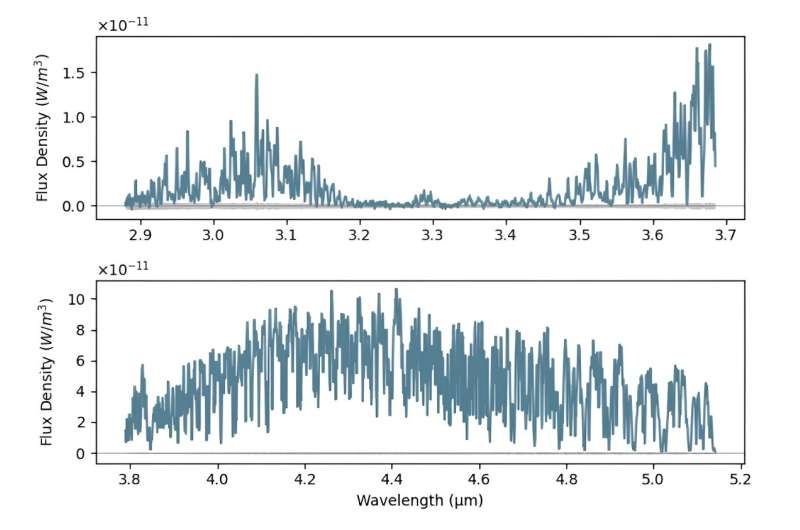February 15, 2024 report
This article has been reviewed according to Science X's editorial process and policies. Editors have highlighted the following attributes while ensuring the content's credibility:
fact-checked
preprint
trusted source
proofread
Astronomers investigate the atmosphere of a nearby cold brown dwarf

Using the James Webb Space Telescope (JWST), astronomers have observed a nearby cold brown dwarf designated WISEPA J182831.08+265037.8 (or WISE 1828 for short). The observations delivered important insights into the composition of the object's atmosphere. The new findings were published Feb. 8 on the preprint server arXiv.
Brown dwarfs are intermediate substellar objects between planets and stars with masses below the hydrogen burning limit—about 80 Jupiter masses. One subclass of brown dwarfs (with effective temperatures lower than 500 K) is known as Y dwarfs, and represents the coolest and least luminous substellar objects so far detected.
Located just 32.37 light years away from the Earth, WISE 1828 is an archetypal type-Y brown dwarf. Previous observations have suggested that it has a radius similar to that of Jupiter's, while its mass is estimated to be about 10 Jupiter masses. The effective temperature of this brown dwarf was found to be 378 K.
Recently, a team of astronomers led by Ben Wei Peng Lew of the Bay Area Environmental Research Institute in Moffett Field, California, has conducted an in-depth atmospheric study of WISE 1828. For this purpose, they employed JWST's Near-Infrared Spectrograph (NIRSpec).
"In this study, we leverage moderate spectral resolution observations (R ∼ 2700) with the G395H grating of the Near-Infrared Spectrograph (NIRSpec) onboard of JWST to characterize the nearby (9.9 pc) Y dwarf WISEPA J182831.08+265037.8," the researchers wrote.
The observations detected water, carbon monoxide, carbon dioxide, methane, ammonia and hydrogen sulfide in the atmosphere of WISE 1828. The authors of the paper noted that their study marks the first measurement of the hydrogen sulfide abundance in an atmosphere of a Y-dwarf.
The study found that WISE 1828 has above-solar abundance ratios of oxygen to hydrogen, sulfur to hydrogen. The abundance ratio of nitrogen relative to hydrogen was estimated to be likely near-solar. The results also suggest a lower-than-nominal abundance of methane-d1.
By using two complementary atmospheric modeling tools, the researchers managed to measure the metallicity and carbon to oxygen abundance ratio of WISE 1828's atmosphere. One model indicates that the metallicity is at a level of 0.3 dex, while the other one points to a metallicity of -0.57 dex. The carbon to oxygen abundance ratios are similar, according to these two models, about 0.46 and 0.43 dex, respectively.
The models allowed the team to also calculate the radius and effective temperature of WISE 1828. One model suggests 1.23 Jupiter radii and 534 K, while according to the other one, the planet is smaller and colder—1.03 Jupiter radii and 425 K.
More information: Ben W. P. Lew et al, High-precision atmospheric characterization of a Y dwarf with JWST NIRSpec G395H spectroscopy: isotopologue, C/O ratio, metallicity, and the abundances of six molecular species, arXiv (2024). DOI: 10.48550/arxiv.2402.05900
Journal information: arXiv
© 2024 Science X Network




















